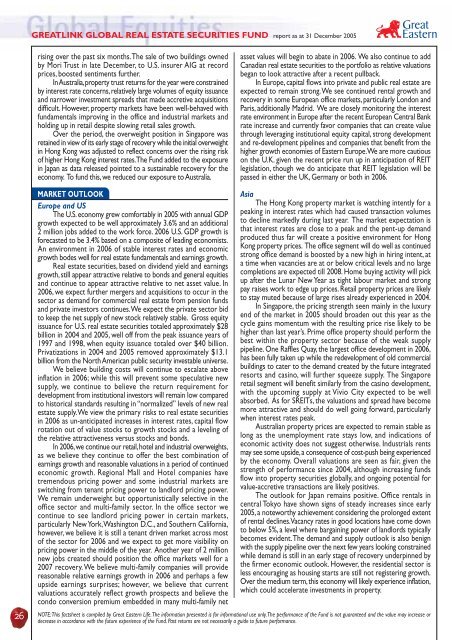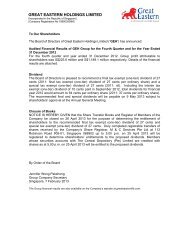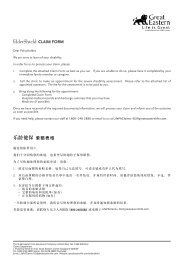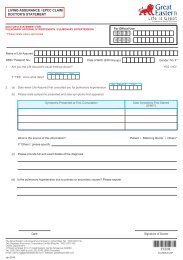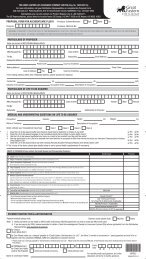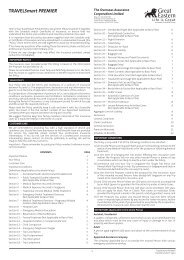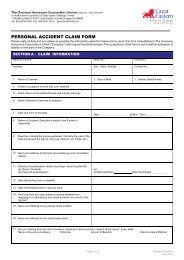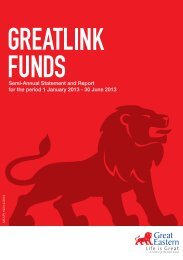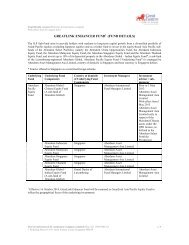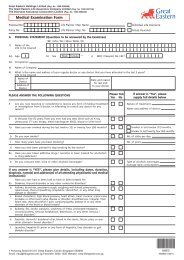Funds GreatLink - Great Eastern Life
Funds GreatLink - Great Eastern Life
Funds GreatLink - Great Eastern Life
You also want an ePaper? Increase the reach of your titles
YUMPU automatically turns print PDFs into web optimized ePapers that Google loves.
GREATLINK GLOBAL REAL ESTATE SECURITIES FUND report as at 31 December 2005<br />
rising over the past six months. The sale of two buildings owned<br />
by Mori Trust in late December, to U.S. insurer AIG at record<br />
prices, boosted sentiments further.<br />
In Australia, property trust returns for the year were constrained<br />
by interest rate concerns, relatively large volumes of equity issuance<br />
and narrower investment spreads that made accretive acquisitions<br />
difficult. However, property markets have been well-behaved with<br />
fundamentals improving in the office and industrial markets and<br />
holding up in retail despite slowing retail sales growth.<br />
Over the period, the overweight position in Singapore was<br />
retained in view of its early stage of recovery while the initial overweight<br />
in Hong Kong was adjusted to reflect concerns over the rising risk<br />
of higher Hong Kong interest rates. The Fund added to the exposure<br />
in Japan as data released pointed to a sustainable recovery for the<br />
economy. To fund this, we reduced our exposure to Australia.<br />
MARKET OUTLOOK<br />
Europe and US<br />
The U.S. economy grew comfortably in 2005 with annual GDP<br />
growth expected to be well approximately 3.6% and an additional<br />
2 million jobs added to the work force. 2006 U.S. GDP growth is<br />
forecasted to be 3.4% based on a composite of leading economists.<br />
An environment in 2006 of stable interest rates and economic<br />
growth bodes well for real estate fundamentals and earnings growth.<br />
Real estate securities, based on dividend yield and earnings<br />
growth, still appear attractive relative to bonds and general equities<br />
and continue to appear attractive relative to net asset value. In<br />
2006, we expect further mergers and acquisitions to occur in the<br />
sector as demand for commercial real estate from pension funds<br />
and private investors continues. We expect the private sector bid<br />
to keep the net supply of new stock relatively stable. Gross equity<br />
issuance for U.S. real estate securities totaled approximately $28<br />
billion in 2004 and 2005, well off from the peak issuance years of<br />
1997 and 1998, when equity issuance totaled over $40 billion.<br />
Privatizations in 2004 and 2005 removed approximately $13.1<br />
billion from the North American public security investable universe.<br />
We believe building costs will continue to escalate above<br />
inflation in 2006; while this will prevent some speculative new<br />
supply, we continue to believe the return requirement for<br />
development from institutional investors will remain low compared<br />
to historical standards resulting in “normalized” levels of new real<br />
estate supply. We view the primary risks to real estate securities<br />
in 2006 as un-anticipated increases in interest rates, capital flow<br />
rotation out of value stocks to growth stocks and a leveling of<br />
the relative attractiveness versus stocks and bonds.<br />
In 2006, we continue our retail, hotel and industrial overweights,<br />
as we believe they continue to offer the best combination of<br />
earnings growth and reasonable valuations in a period of continued<br />
economic growth. Regional Mall and Hotel companies have<br />
tremendous pricing power and some industrial markets are<br />
switching from tenant pricing power to landlord pricing power.<br />
We remain underweight but opportunistically selective in the<br />
office sector and multi-family sector. In the office sector we<br />
continue to see landlord pricing power in certain markets,<br />
particularly New York, Washington D.C., and Southern California,<br />
however, we believe it is still a tenant driven market across most<br />
of the sector for 2006 and we expect to get more visibility on<br />
pricing power in the middle of the year. Another year of 2 million<br />
new jobs created should position the office markets well for a<br />
2007 recovery. We believe multi-family companies will provide<br />
reasonable relative earnings growth in 2006 and perhaps a few<br />
upside earnings surprises; however, we believe that current<br />
valuations accurately reflect growth prospects and believe the<br />
condo conversion premium embedded in many multi-family net<br />
asset values will begin to abate in 2006. We also continue to add<br />
Canadian real estate securities to the portfolio as relative valuations<br />
began to look attractive after a recent pullback.<br />
In Europe, capital flows into private and public real estate are<br />
expected to remain strong. We see continued rental growth and<br />
recovery in some European office markets, particularly London and<br />
Paris, additionally Madrid. We are closely monitoring the interest<br />
rate environment in Europe after the recent European Central Bank<br />
rate increase and currently favor companies that can create value<br />
through leveraging institutional equity capital, strong development<br />
and re-development pipelines and companies that benefit from the<br />
higher growth economies of <strong>Eastern</strong> Europe. We are more cautious<br />
on the U.K. given the recent price run up in anticipation of REIT<br />
legislation, though we do anticipate that REIT legislation will be<br />
passed in either the UK, Germany or both in 2006.<br />
Asia<br />
The Hong Kong property market is watching intently for a<br />
peaking in interest rates which had caused transaction volumes<br />
to decline markedly during last year. The market expectation is<br />
that interest rates are close to a peak and the pent-up demand<br />
produced thus far will create a positive environment for Hong<br />
Kong property prices. The office segment will do well as continued<br />
strong office demand is boosted by a new high in hiring intent, at<br />
a time when vacancies are at or below critical levels and no large<br />
completions are expected till 2008. Home buying activity will pick<br />
up after the Lunar New Year as tight labour market and strong<br />
pay raises work to edge up prices. Retail property prices are likely<br />
to stay muted because of large rises already experienced in 2004.<br />
In Singapore, the pricing strength seen mainly in the luxury<br />
end of the market in 2005 should broaden out this year as the<br />
cycle gains momentum with the resulting price rise likely to be<br />
higher than last year’s. Prime office property should perform the<br />
best within the property sector because of the weak supply<br />
pipeline. One Raffles Quay, the largest office development in 2006,<br />
has been fully taken up while the redevelopment of old commercial<br />
buildings to cater to the demand created by the future integrated<br />
resorts and casino, will further squeeze supply. The Singapore<br />
retail segment will benefit similarly from the casino development,<br />
with the upcoming supply at Vivio City expected to be well<br />
absorbed. As for SREITs, the valuations and spread have become<br />
more attractive and should do well going forward, particularly<br />
when interest rates peak.<br />
Australian property prices are expected to remain stable as<br />
long as the unemployment rate stays low, and indications of<br />
economic activity does not suggest otherwise. Industrials rents<br />
may see some upside, a consequence of cost-push being experienced<br />
by the economy. Overall valuations are seen as fair, given the<br />
strength of performance since 2004, although increasing funds<br />
flow into property securities globally, and ongoing potential for<br />
value-accretive transactions are likely positives.<br />
The outlook for Japan remains positive. Office rentals in<br />
central Tokyo have shown signs of steady increases since early<br />
2005, a noteworthy achievement considering the prolonged extent<br />
of rental declines. Vacancy rates in good locations have come down<br />
to below 5%, a level where bargaining power of landlords typically<br />
becomes evident. The demand and supply outlook is also benign<br />
with the supply pipeline over the next few years looking constrained<br />
while demand is still in an early stage of recovery underpinned by<br />
the firmer economic outlook. However, the residential sector is<br />
less encouraging as housing starts are still not registering growth.<br />
Over the medium term, this economy will likely experience inflation,<br />
which could accelerate investments in property.<br />
26 NOTE: This factsheet is compiled by <strong>Great</strong> <strong>Eastern</strong> <strong>Life</strong>. The information presented is for informational use only. The performance of the Fund is not guaranteed and the value may increase or<br />
decrease in accordance with the future experience of the Fund. Past returns are not necessarily a guide to future performance.


